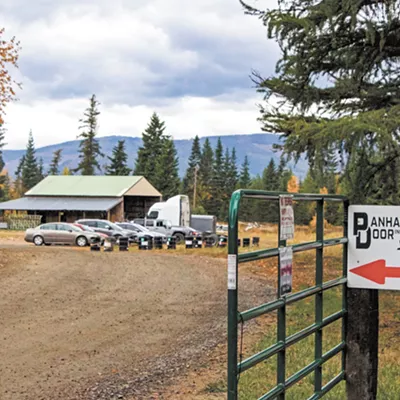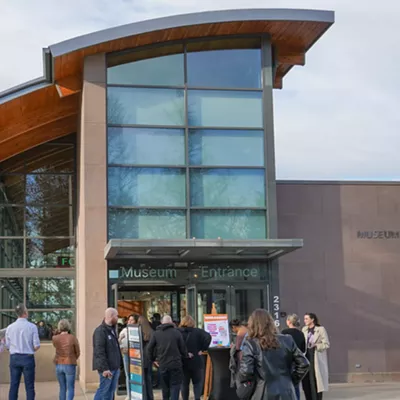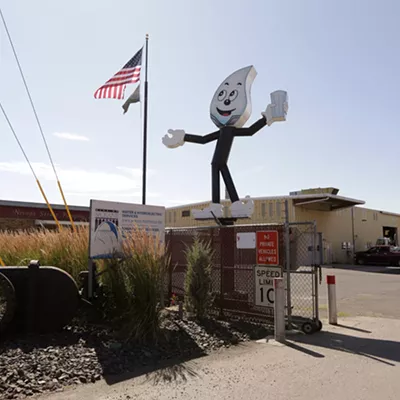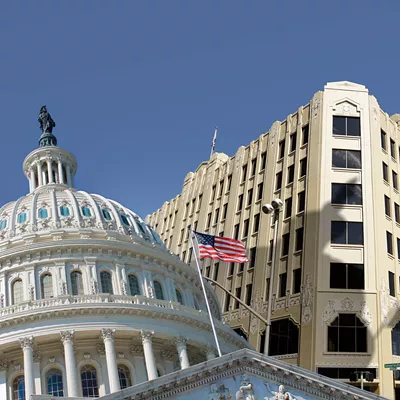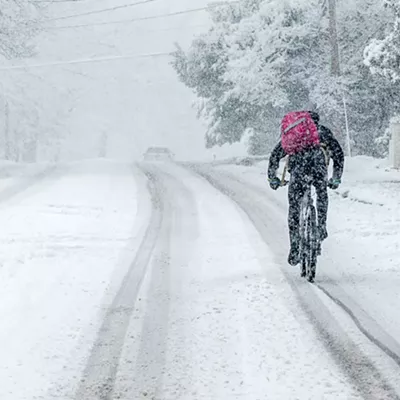It’s 8:30 pm on a Monday night. It’s beginning to get cold — the first below-freezing night of the season is upon them. And the near constant vigil of Occupy Spokane protesters, below the Monaghan statue at Monroe Street and Riverside Avenue, continues.
On this night, there are five occupiers. The small red “A” pin on protester Steve Siegfried’s lapel doesn’t stand for “Anarchy,” he says. It stands for Spokanarchy, the movie made about the Spokane punk scene Siegfried says he was a part of back when he was 22. Now, he’s 53 — and the rebellious activist has reawakened.
“I know it’s going to get miserable out here,” Siegfried says, peering out under shaggy hair and a beanie. “But I know I’ll be out here.”
He says he wants money out of politics, for the government to get corporations under control, and fair wages for the working man. He wants change, and he says he’ll keep coming to these protests — an echo of the protests running in New York since September 17.
Occupy’s march over the weekend was smaller than the one a week before, which had an estimated 400 people, Siegfried says. He blames the rainy weather and a more haphazard organization. But the number of occupiers has grown, he says. On Sunday night, he says, there were still six protesters out at 3 am.
One night, at 4 am, he says he and some fellow protesters helped stop two men assaulting a young woman near the Masonic Temple. In the weeks ahead, he says, he looks forward to protesters wearing signs detailing their occupation, a counter to the “Get a job!” cries some drivers have yelled at them. Seigfried says he has two — custodial and landscaping.
“The entire country was asleep for the last 10 years,” Siegfried says. “They’re beginning to wake up.”
That includes Colville, Wash., which launched an “Occupy Colville” movement this week. (Daniel Walters)
Inlander HQ has a pretty good view of the railroad tracks. It’s universally accepted around here that the finest cargo to pass our windows are either giant white blades for new wind turbines, or wingless green jet fuselages.
Something we’ll be seeing more of, however, are train cars filled with coal.
In a twist of economic irony, this year Washington officially set a date to shut down the state’s last coal-fired power plant while at the same proposing to build two new coal export terminals to ship the stuff out of the country. To get the coal — which comes from the nation’s interior — to these terminals, it will need to go through Spokane. Specifically, up to 160 million tons of coal every year could go through Spokane, on 50 separate trains, each up to a mile-and-a-half long, to feed power-hungry China.
The Spokane Riverkeeper, Bart Mihailovich, has taken it
upon himself lately to inform the city of all this coal. This Thursday,
Mihailovich is hosting a forum to discuss the potential impacts of
moving so much coal through the center of the city. Spokane City Council
members Amber Waldref and Bob Apple will be on the forum, as will Matt
Krogh, North Sound Baykeeper from Bellingham; Dr. Robert Tuckner, a
local air quality and railroad emissions expert; and Gary Stevens, a
hydrologist with the Idaho Department of Environmental Quality.
Join in, Thursday, Oct. 27, at the Lincoln Center, 1316 N. Lincoln, at 5:30 p.m. (Nicholas Deshais)
Clean Suit
In July, environmental advocacy groups told the Environmental Protection Agency that they would sue the government agency unless it did something to clean up a specific type of toxin in the Spokane River.
It didn’t. So they did.
The EPA has failed to properly regulate the discharge of a cancer-causing chemical into the Spokane River, according to John Osborn, chair of the Sierra Club Upper Columbia River Group, which filed suit with the Center for Environmental Law & Policy this week against the EPA. Osborn says the agency has bent to the will of polluters.
“Why has the EPA not taken action? I think it’s because you’re dealing with the power of the dischargers,” says Osborn, a Spokane physician. “I mean, look at who has pipes in the river and who wants to put pipes in the river, and you’re dealing with some very powerful political players.”
Osborn says the EPA has failed to develop a plan to limit carcinogenic PCBs in the Spokane River, as is mandated by the federal Clean Water Act. PCBs were widely used in industrial construction before being banned more than 30 years ago, but the chemical is still prevalent in the environment. The EPA has instead deferred to the state Department of Ecology, but Osborn says their plan relies too heavily on industry to police itself. (Chris Stein)
Council Action
Spokane council members disapproved of two ballot measures and gave themselves the option to cut their own salary this week.
The Spokane City Council was unanimous in passing an ordinance by Councilman Richard Rush allowing members to cut their own pay by 3 percent.
The council also passed a resolution disapproving of state ballot Initiative 1125, a Tim Eyman initiative that would restrict how revenue from road tolls could be spent.
Another enacted resolution condemned city Proposition 1, also known as the Community Bill of Rights, which opponents say would hinder employers, and supporters say would empower citizens against corporations. (Chris Stein)






